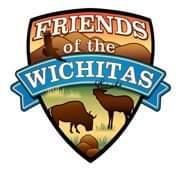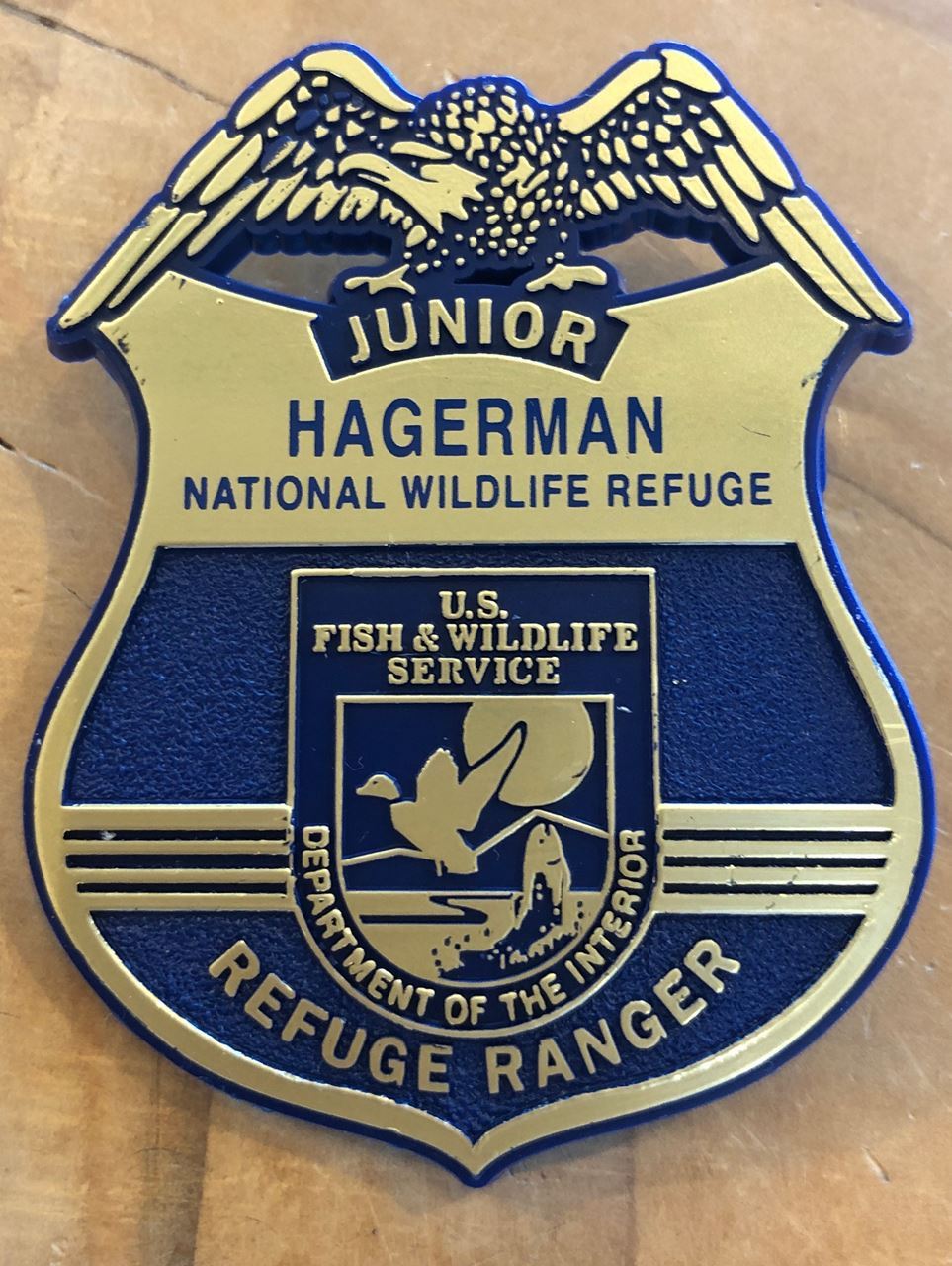Named for a Noise
by Renny Gehman
Photo by Pam Rendall-Bass
You’re walking along one of Hagerman’s roads when you notice a bird ahead of you, moving in short spurts on its spindly legs. It stops, seizes some beetle in its pointed bill, then runs forward again. As you turn aside to observe it more closely, it bursts into the air, giving off a sharp call: kil—dee, kil—dee. That’s when you realize you’ve met one of Hagerman’s common visitors—the Killdeer. They’re named for their call.
Oddly enough, though Killdeer are plovers, and one of our most common shorebirds, they are often found away from water, on gravel roads and parking lots or fields and lawns. They enjoy open, flat, relatively dry areas with short grass where they are commonly seen foraging for insects, worms, and snails. It’s easy to tell if they’re hunting for food because they perform a maneuver called dash and dine. They often pat their foot to stir up prey, tilt their heads
sideways to spot movement, dash ahead to seize the target with their elongated bill—and then repeat.
Another distinctive behavior that Killdeer often display is what I like to call their “look at me, I’m hurt” ruse which they perform when a predator—or anyone—gets too close to their nest. The female may be standing quietly when suddenly she moves away, dragging what appears to be a hurt or broken wing in the dust and crying, kil-dee, kil-dee, piteously. The killdeer will keep this up for a few feet and then, seemingly miraculously, take off and fly away. This behavior is designed to lure a perceived danger away from their eggs which actually aren’t in a nest at all but simply laid on open ground, or in a shallowly scraped depression, where their brown spots and blotches help them blend into their surroundings. Photo by Pam Rendall-Bass Killdeer are easy to tell apart from other plovers even without these characteristic movements because of their readily distinguishable markings. About the size of a robin but with longer legs and wings, Killdeer are brownish-tan on top and white below. Their chests are barred with two, easy to see, black bands and topped with a white neck ring while their brown faces sport black and white patches. They also have a distinctive bright orangey-buff rump which is very visible in flight or during the “look at me, I’m hurt” display. Other noticeable markings are the white wing stripe and elongated tail which they also spread during their broken wing act. Killdeer are the most widespread North American plover species and breed from central Alaska east to Newfoundland, down through the United States and well into Mexico. They arrive in Hagerman from their South American wintering grounds in early February, although some may be found in Texas year-round. Courting occurs soon after arrival. The first eggs are usually laid by early March, and they often have several nest attempts per year but peak nesting occurs in April. The handsome and easy to identify Killdeer is one bird species that has adapted well to human-altered habitats, probably because our grassy lawns, gravel parking lots, city and suburban parks, as well as open pastures provide them optimum habitat. They even nest on rooftops! Both male and female help build the nest, |
scraping it out of the ground and lining it with small rocks, or the like. Killdeer nests are always well camouflaged but if you see mama or papa doing the broken wing act, you can be sure a nest is close by. The chicks hatch with eyes open and are covered in downy fluff. They leave the nest almost immediately and follow their parents around.
Photo by James Waghorne
Because of where they nest, Killdeer are vulnerable to collisions with cars and mowing equipment. Marking nest locations can help, as well as keeping a lookout for them while driving. The good news is that there are probably more Killdeer in Texas today than ever, and they are certainly easy to spot at Hagerman. Even though many of the Refuge’s roads were flooded, the regular Tuesday bird count still recorded three Killdeer on May 7th, very average for this time of year.
So keep your eyes peeled for these feathered performers and enjoy their distinctive calls. There aren’t a lot of birds that make themselves so easy to identify. A Killdeer is a lot of fun to observe and one children enjoy watching.
Just remember to stay away from their nests!
Photo by Renny Gehman
Choctaw Cultural Day was a Huge Success Enjoyed by over 200 Visitors Photos by Nelda Zamir |
|
Live! Bluebirds in the Visitor Center! Come and see Momma Bluebird feeding her nestlings!
Our live streaming nestbox in the Visitor Center may soon have four chicks! Definitely worth a trip to the Visitor Center to see this miracle of nature. |
Volunteers Wanted: Join Our Communications Team!
Have you used Microsoft PowerPoint or Publisher? Then you have the skills to help our communications team with promoting our events and working towards the Friends of Hagerman NWR mission to instill reverence, respect, and conservation of our wild creatures and habitats through supporting environmental education, recreational activities, and programs of Hagerman National Wildlife Refuge and the U.S. Fish and Wildlife Service.
Work from home on meaningful projects, reaching thousands of nature-lovers like yourself, while being a member of a productive team. Email: friendsofhagerman@gmail.com for more information.
Plant of the Month: Chocolate Daisy By Donna Rogers A favorite native flower, the chocolate daisy (Berlandiera lyrata), is named after French-Swiss physician Jean-Louis Berlandier, who gathered plants in Texas and northern Mexico in the 1800s. Growing chocolate flower plants in the garden sends the scent of chocolate through the air, and the fragrance is especially potent when sniffed up close. The yellow, daisy-like flowers of the chocolate daisy attract butterflies, hummingbirds, and other pollinators. Its native habitat includes dry, rocky limestone with well-drained soil, and includes locations such as roadsides, vacant lots, plains, mesas, grasslands, and other disturbed soil locations. Heavy soil with wet conditions, however, can lead to root rot. Chocolate daisy is a mounding perennial wildflower native to the southwestern USA and Mexico in the Asteraceae (daisy) family. Sometimes referred to as green-eyes, this name comes from the green disk-shaped flower center that remains after the petals fall off. When conditions become too wet, the plant can become top heavy; however, branchlets will form along the prone stem, and additional flowers will bloom. An herbaceous perennial, the... Enjoy gardening? Join the Wednesday Garden Group Today! Email: friendsofhagerman@gmail.com for more information. |
Birding with Jack: The Weekly Bird Census Left to Right: Mike Petrick, Nancy Riggs, Jack Chiles and Terry Goode Each Tuesday a team of experienced birders, including Master Naturalist Jack Chiles, traverse 35 miles of refuge roads and hiking trails, documenting every bird they encounter. This Bird Census is reported to The Cornell Lab of Ornithology for use in research, and each week we will bring you a link to their actual bird count, and a summary of their adventures.
Red-shouldered Hawks and Northern Rough-winged Swallow The day started out stormy for the census but cleared up some by 10:30. The pad roads are now open but I don't know for how long with more rain and storms in the forecast. Early on we found a Red-breasted Merganser in the pool on the left before you get to Plover Pad. Birding was pretty slow until the rain let up. We got a couple of first of year swallow species, Tree Swallow and Northern Rough-winged Swallow. We found a lone Buff-breasted Sandpiper in an area on the north side of Silliman Rd. We found a couple of warbler species, Prothonotary Warbler and Black-and-white Warbler, We saw over 200 Western Cattle Egrets today. We had a total of 3 Eastern Kingbirds. There was a Bewick's Wren singing near the residences on the road to the Goode Area. We finished the day with 78 species which was not bad considering the slow start. Today's photos, the young Red-shouldered Hawks near the Big Mineral Picnic Area, that seem to be doing well and the Northern Rough-winged Swallow we saw at Meadow Pond. See the rest of Jack's notes and the latest Bird Census Results |
The Friends of Hagerman NWR Photo Club |
PHOTO CLUB FIELD TRIP: WICHITA MOUNTAINS WILDLIFE REFUGE Join us for a special photography guided tour of Wichita Mountains Wildlife Refuge (WMWR) in Oklahoma. The Friends of the Wichitas will be leading a 30-person tour bus to take our photo club members to areas on the Wichita Mountains Wildlife Refuge for photography opportunities. This event is limited to FOHNWR Nature Photography Club members only. Once the maximum number of registrations is reached, you may still register and will be added to the wait list. If someone cancels their registration, the top of the wait list will be contacted to fill the spot.
A separate email will be sent to the registrants with details. Check your email for the latest information from FOHphotoclub@gmail.com. Agenda for June 5, Wednesday
Info
For questions about this event, contact: Lisa Wilkins, Event Leader Mobile 972-658-8544 Email FOHphotoclub@gmail.com |
Join Cindy Steele for:
The Refuge Rocks! Programs for Children
Future events
- No upcoming events
| Puddles' Craft Corner By Cindy Steele, Master Naturalist |
Welcome back to Puddles’ Craft Corner!
Legend has it that seeing or catching a ladybug is a sign of good luck! If you ever come across this peaceful insect, you can gently catch it but then make a wish and let it go. But, even if you do believe in this tale, you don’t want to bring this insect inside your home or any building, as they can multiply or reproduce and overtake structures. It’s fun to go on a flower safari…looking and taking pictures of beautiful flowers and hunting for bugs like ladybugs but be aware of private land. Don’t walk on private property and don’t pick flowers on private land.
Ladybugs are not just delightful and charming garden residents! They are also nature's tiny guardians, silently working to protect your plants from harmful pests. Also known as ladybirds or lady beetles, ladybugs are predators with a mighty appetite for plant-eating insects. Their favorite snacks are aphids, mealybugs, mites, and scale insects - all common pests that can wreak havoc in your garden!
There are about 5,000 different species of ladybugs in the world. They come in many different colors and patterns, but the most familiar in the US is the seven-spot ladybird, which has a shiny, red-and-black body. Most people like ladybugs because they are pretty, graceful, and harmless to humans. But farmers love them because they eat aphids and other plant...
Junior Ranger Program: Advanced and Intermediate
|
| The Junior Ranger Pledge As a Junior Ranger at Hagerman National Wildlife Refuge, I pledge to protect outdoor creatures small, big and huge. To keep the water, air and land clean. To make enjoying nature a routine. I will share my new skills with family and friends. When people and nature work together, everybody wins! |
|
Sponsors Enable the Friends to…
Join Today! Memberships available for $10 |
|
|
Group Tram Tour |
Register for a Tram Tour Today!
Butterfly Garden Walks
Registration is not necessary |
Pipevine Swallowtail (right) by Laurie Sheppard |
Sunrise at the Little Sit by Laurie Sheppard | Photo by Cathy Van Bebber |
Meet Jack and the Bird Census Team and learn how to identify the birds of North Texas while enjoying the beautiful sunrise over Lake Texoma! Modeled after Cornell's national "Big Sit" event, a group of dedicated birders invite you to join them at sunrise to conduct a bird count as multiple species fly to the water and the surrounding land to feed. Leaders will bring spotting scopes and will provide tips for identification of the many species you will see. This event lasts a couple of hours, but all are welcome to come and go as they please. Participants are advised to bring a chair, binoculars and water. The First Saturday of every month, beginning 30 minutes before sunrise. |
Location: H Pad, Sadler, Texas 76264 (H Pad is in Sadler, but it is part of the refuge) GPS Coordinates: 33.734961, -96.780582
|
|
Early Bird Walk with Jack Chiles |
No pictures to show |
Master Naturalist Jack Chiles will lead our Early Birding event, weather permitting. Bring binoculars or borrow ours. Meet at the Visitor Center and return in time for the Second Saturday program. |
Please Register (Optional) so we may inform you via email of unforseen changes/cancellations. Bird walks are not held in the summer months due to the heat. |
Second Saturday: Shrews with Bryon Clark Saturday, June 8th at 10:00 AM in the Visitor Center This presentation will focus on the life history and ecology of the four species of shrews that occur in Texas, with emphasis on the Southern Short-tailed Shrew and Least Shrew found in the Blackland Prairie ecoregion. Even though shrews are one of the most diverse groups of mammals, they are still one of the least studied. Shrews are small mammals with long, pointed noses, inconspicuous ears, minute eyes, and a short tail. They have short, dense, velvety fur and like other shrews in North America, their teeth have a chestnut color. Shrews have a high metabolic rate and voracious appetite; several species have a venomous saliva that aids in subduing their prey. Dr. Bryon Clark has been a nature enthusiast since growing up on the family farm in southern Iowa. He has a B.A. in Biology from Central College in Iowa, a M.S. in Biology from Western Illinois University, and a Ph.D. in Biology from Kansas State University. He is a mammalian ecologist; his research focused on the ecology and natural history of small mammals including bats, rodents, and shrews. He served on the faculty and administration at Southeastern Oklahoma State University for 30 years until his retirement in 2020. Bryon is the immediate past President of the Friends of Hagerman Board, member of the Board of Directors of the Texoma Audubon Society, and a certified Texas Master Naturalist. He enjoys sharing stories and information about nature to anyone that will listen. Future Second Saturday Programs |
|
Do You Like to Work Outside? The Refuge Needs You! |
It takes a lot of people to have a beautiful garden! The Wednesday Garden Team Love to work with native plants and meet other gardeners? Come and help us add plants, weed and mulch our beautiful butterfly garden. Garden Team volunteers get first dibs on thinned native plants as well as access to seeds and cuttings for propagation. Gardeners meet on most Wednesdays, but times vary. Contact Us to subscribe to the volunteer garden team weekly email. Provide own tools and gloves. Minimum age 18, or 16 if accompanied by parent/volunteer. |
Mowing and Refuge Beautification: The Work Crew Do you enjoy working outside, mowing, sprucing up hiking trails, trimming and removing brush and general cleanup? Show your love for nature by joining the Outdoor Crew at Hagerman National Wildlife Refuge. Outdoor Crew volunteers meet on the First Tuesday and Fourth Saturday of every month. Contact Us for exact times, dates and other details about joining the volunteer Work Crew. Scouts welcome! |
Visitor Center Volunteers Needed! |
Do you enjoy meeting all kinds of people from all over the world, and like-minded people in our area? If yes, consider joining our team of Visitor Center Volunteers. You will greet refuge guests, distribute maps and other refuge information, and make sales in the gift shop. Shifts available every day of the week: Monday through Saturday 9 AM to 12:30 PM and 12:30 to 4:00 PM, Sunday 1:00 to 5:00 PM. Training is provided. Contact Us if interested. |
| Thank You To Our Contributors: Jack Chiles, Cindy Steele, Renny Gehman, Bryon Clark. Nelda Zamir, Pam Rendall-Bass, James Waghorne, Eileen Sullivan Refuge Manager: Kathy Whaley Deputy Refuge Manager: Paul Balkenbush Visitor Services Manager: Spencer Beard Friends of Hagerman NWR Foundation 6465 Refuge Road, Sherman, TX 75092 Phone: 903-786-2826 Join us on Facebook: |
Search for any word--do not use quotes for phrases |
Kroger: Stop by the customer service desk at Kroger and link your Kroger Card to the Friends of Hagerman: the Friends will get rewards for every dollar you spend, at no cost to you.
Please add info@friendsofhagerman.org to your contacts to ensure delivery of registration confirmations, account information and the Featherless Flyer
See you at the refuge!

















